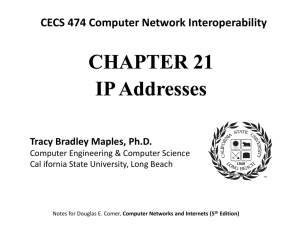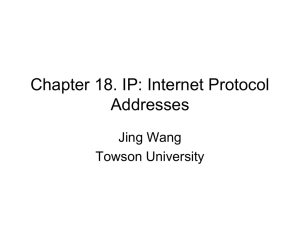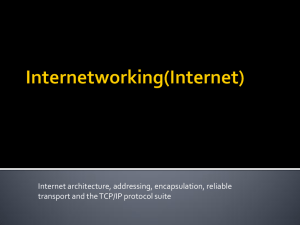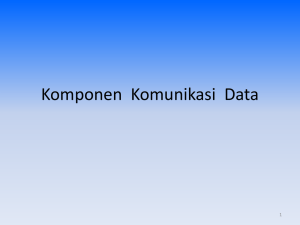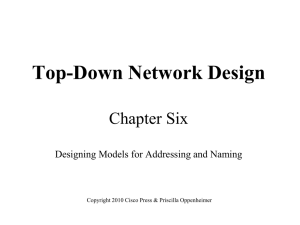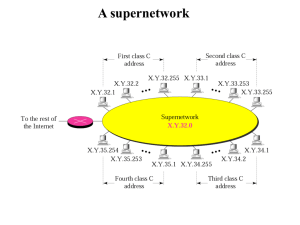IP Addressing
advertisement
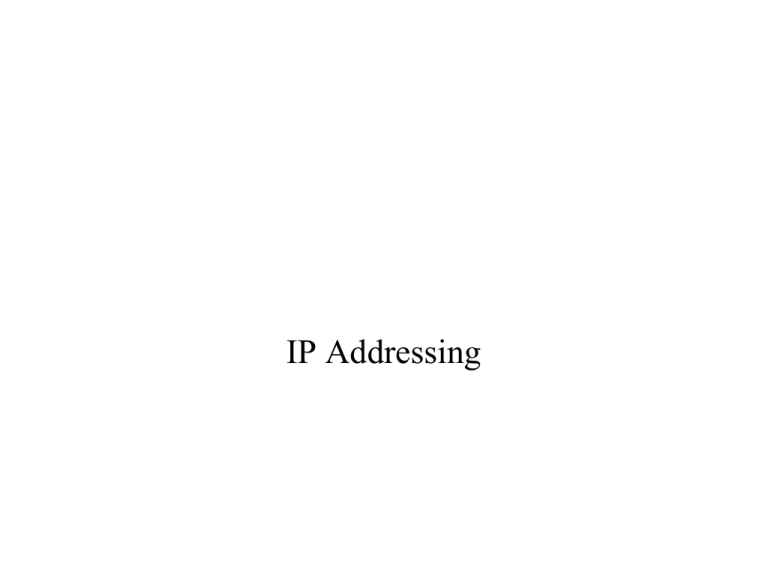
IP Addressing IP Addressing • A 32-bit logical naming convention used on the Internet • A dotted-decimal notation is used: – 170.56.70.1 • Part denotes the network and part denotes the client on the network • IP address must be unique and clients on the same network must have the same network ID • IP Classes – – – – – Class A- Starts with 0, range of 1-127 Class B – Starts with 10, range of 128 - 191 Class C – Starts with 110, range of 192 - 223 Class D – Starts with 1110, range of 224 – 239 Class E – Starts with 1111, range 240 – 255 IP Addressing Contiuned • IP address come pared with a subnet mask • There is a default subnet mask for each IP class – Class A 255.0.0.0 – Class B 255.255.0.0 – Class C 255.255.255.0 • The subnet mask tells what part of the IP address denotes the network and which part denotes the client Division of Address Space • The IP class scheme does not divide the 32-bit address space into equal size classes Authority for Addresses • An organization obtains its IP network numbers from an Internet Service Provider (ISP). • ISPs coordinate with a central organization, the Internet Assigned Number Authority, to ensure that each network prefix is unique throughout the entire Internet. A Classful Example • When assigning a network prefix, a number must be chosen from class A, B, or C • Usually networks are assigned a class C address • For networks connected to the global Internet, a service provider makes the choice. • For a private network, the local network administrator selects the class A Classful Example Classless Addressing • The original classful scheme was limiting • IP addresses were being exhausted • Many assigned network numbers caused many addresses to be unused • New mechanisms were developed: – Subnet addressing – Classless addressing • Idea: Instead of having three distinct address classes, allow the division between prefix and suffix to occur at any bit Why Classless Addressing Helps • Consider a network that contains 9 hosts • Only 4 bits of host suffix are needed to represent all possible host values. • However, a class C address has names for 256 hosts. • Classless addressing solves this problem by allowing an ISP to assign a prefix that is 28 bits long and the suffix then is 4 bits long. • With 4 bits for the suffix, there are 16-2 = 14 host numbers Address Masks • Classless addressing requires an additional bit of information with each address • This additional information specifies the exact boundary between the network prefix and the host suffix. • Thus with classless addressing, tables inside hosts and routers must contain two pieces of information: the 32-bit address and another 32 bit value that specifies the boundary between the prefix and the suffix (subnet Address Masks Continued • The subnet mask is stored as a 32-bit binary number • This allows for efficiency in extracting the network part of the IP address by the host or router • The prefix portion of the IP address needs to be compared to values in the routing table. • This can be done in two machine How Routing Table Comparison is Done • Suppose D is a packet final destination • Suppose (A, M) represents a 32-bit network Address and a 32-bit Mask entry in the routing table • The router tests the condition: Is A = (D &M) ? • M = 255.255.0.0 • A = 128.10.0.0 • D = 128.10.2.3 CIDR Notation • 128.10.0.0/16 • This notation specifies that the first 16 bits of the address make up the network prefix CIDR Address Block Example • If an ISP has two computers each with only 12 computers each, the ISP can use CIDR to partition a class B IP address into three parts: two for each of the customers and the remainder available for future use. • One customer can be assigned: 128.211.0.16/28 • The other customer can be assigned: 128.211.0.32/28 CIDR Host Addresses Special IP Addresses Routers and IP Addressing Principle • Routers are assigned IP addresses as well as host machines • A router may be assigned two or more IP addresses Homework 14 • Finish reading Chapter 21 • Question. You have a network ID of 150.150.0.0 and you need to divide it into multiple subnets. You need 600 host IDs for each subnet, with the largest amount of subnets available. Which subnet mask would you use: 255.255.224.0; 255.255.240.0; 255.255.248.0; 255.255.252.0

